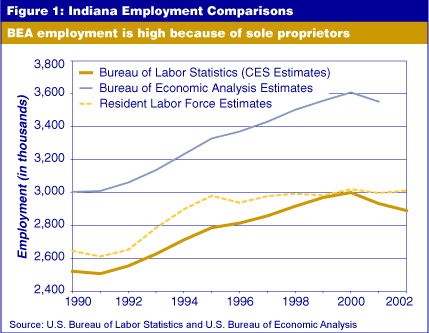The Job Truth Is Out There—But Where?
No two events cause people to look at economic indicators with greater zeal than a tough economy and an election. Both are happening in Indiana right now and the spotlight is on job losses. Or is it on employment gains?
Indulge us, because the questions are flying fast and furious out there about record job losses and record numbers of Hoosiers employed. How can that be? Well, because the figures that go along with those two “facts” come from different sources using different ways of collecting the data, we wind up comparing apples and oranges—which might make a good fruit salad but it doesn’t provide good information on which to base decisions.
The Apples
The job losses we hear about every month are based on a survey of approximately 7,000 Indiana employers, producing an estimate of the number of jobs in Indiana and its metropolitan areas. This survey is conducted each month by the careful statisticians at the Indiana Department of Workforce Development, as part of the national program run by the U.S. Bureau of Labor Statistics. The key words used to describe this survey are payroll and employer—essentially establishments with a payroll who pay quarterly unemployment insurance taxes. Keep in mind that what the employer does is offer jobs. Those jobs are based on where the employer is located, not on where the workers live.
But not everyone works for someone else—and those who don’t take orders from others are not counted in the payroll survey. Who might these people be? Consultants, lawyers, solo practice doctors, the guy down the street with his own lawn care service who hires kids after school to help, the flower shop owner whose children come in after school or the software developer who has a bit of a nest egg right now and can afford to develop some new code for advanced manufacturing. According to the Bureau of Economic Analysis (BEA), Indiana’s sole proprietors tally is growing yearly and was well over a half-million just two years ago.
Bottom line: The jobs number is important, but it is only a partial picture of Hoosiers at work. Indiana has lost jobs. Hoosiers, however, are still working, maybe not in Indiana or at a place with lots of employees (and a payroll), but either for themselves or for a relative. Sadly, some of them may be under-employed, having lost a good-paying manufacturing job and finding a lower paying one in the faster growing services sectors.

The Oranges
The record number of people living in Indianapolis who are working is based on the Resident Labor Force Estimates. To tally up your county or state resident labor force, you must add together the people who live in your county or state who are working and those people who aren’t working but want to and are seeking work—that is, the employed and the unemployed. Key words: resident and people. A person can have more than one job, so employed people may not equal jobs. They are people with a job or multiple jobs, but the key is that it is a person number and it is based on where they live, not on where they work. Remember, people can commute (oh lucky us!) to distant counties and even out-of-state in order to work.
Bottom line: More Hoosiers are working, but the bigger question today is working where and for whom? Survey-based estimates don’t tell us that as of yet, so we can only guess that, with the focus on entrepreneurial activities in Indiana over the past couple of years, we will see many more people starting their own companies—and those small start-ups might include the next big thing.
Carol O. Rogers
Associate Director, Indiana Business Research Center,
Kelley School of Business, Indiana University
